Royal Navy Escort carriers adapted from merchant ship hulls in the Second World War
British-built Escort carriers adapted from merchant ship hulls: Activity, Campania, Nairana, Vindex, 4 ships built in Britain - c12,000 tons, 17 knots, 15 aircraft, 700 crew, laid down in 1942-44.
HMS Activity (D94)
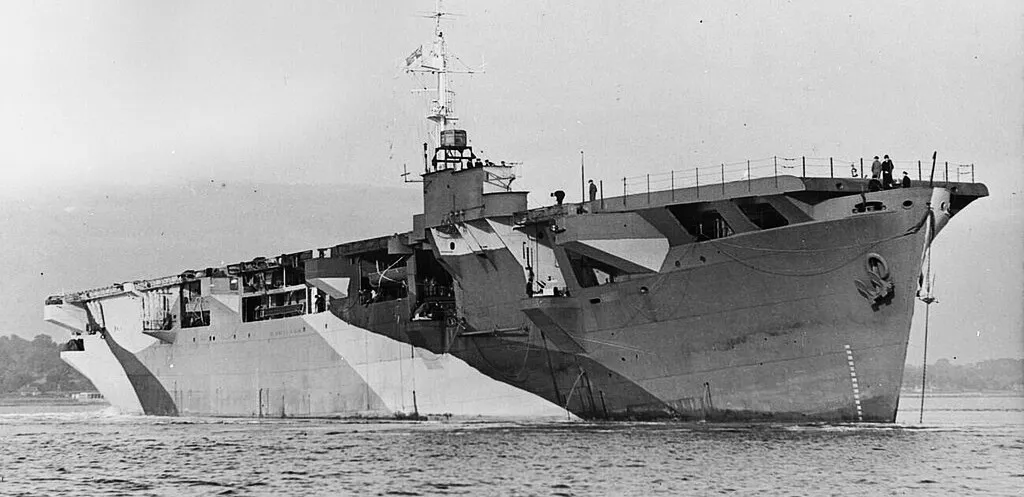
(IWM Photo, FL 137)
HMS Activity (D94) underway in the Firth of Forth, October 1942.
HMS Activity was an escort carrier that served with the Royal Navy of the United Kingdom during the Second World War. After the war, she was sold into merchant service as the MV Breconshire, serving for over 20 years until scrapped in 1967. (Wikipedia)
HMS Campania (D48)
_at_anchor_1944.webp)
(IWM Photo, NH 79613)
HMS Campania (D48) at anchor. Seven Fairey Swordfish and three Grumman Wildcat aircraft are visible on deck, 22 June 1944.
HMS Campania (D48) was an escort aircraft carrier of the Royal Navy that saw service during the Second World War. After the war, the ship was used as a floating exhibition hall for the 1951 Festival of Britain and as the command ship for the 1952 Operation Hurricane, the test of the prototype British atomic bomb.She was built at Harland & Wolff shipyards in Belfast, Northern Ireland. When construction started in 1941 she was intended as a refrigerated cargo ship for transporting lamb and mutton from New Zealand, but was requisitioned by the British Government during construction and completed and launched as an escort carrier, entering service in early 1944.The ship was of a similar, but not identical design to the other ships of the Nairana class. (Wikipedia)
HMS Nairana (D05)
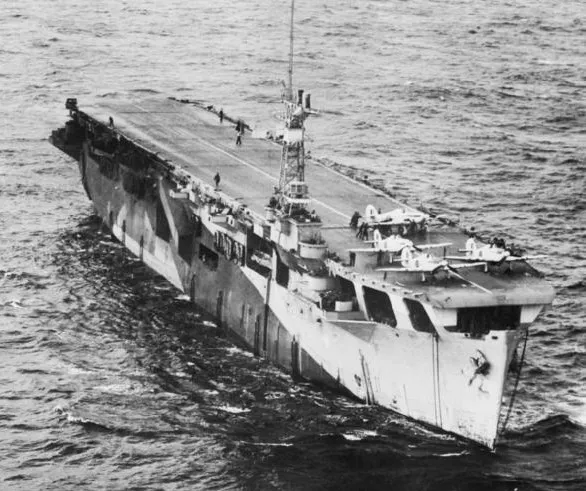
(IWM Photo, FL 12664)
HMS Nairana (D05) under way with Sea Hurricanes on her foredeck. She was transferred to the Royal Netherlands Navy in 1946 and was renamed HNLMS Karel Doorman (QH1).
HMS Nairana (D05) was the lead ship of the Royal Navy's Nairana-class escort carriers that saw service in the Second World War. She was built at John Brown & Company shipyards in Clydebank, Scotland. When construction started in 1941 she was intended as a merchant ship, but was completed and launched as an escort carrier, entering service at the end of 1943. Nairana operated escorting convoys and doing anti-submarine work in the Atlantic and Arctic theatres. On 26 May 1944, Royal Navy Sea Hurricanes operating from Nairana claimed the destruction of three Junkers Ju 290s during the defence of a convoy. This represented 10 percent of the total German inventory of the type. She survived the war, and in 1946 was transferred to the Royal Netherlands Navy as the Karel Doorman (QH1), the first Dutch aircraft carrier. In 1948, she was replaced in the Royal Netherlands Navy by another vessel of the same name. Nairana was returned to the Royal Navy, and sold to the Port Line company, becoming the merchant ship Port Victor. (Wikipedia)
_(2158_000837).webp)
(Fotoafdrukken Koninklijke Marine Photo)
Hr.Ms. Karel Doorman (QH1), Royal Netherlands Navy.
HMS Vindex (D15)
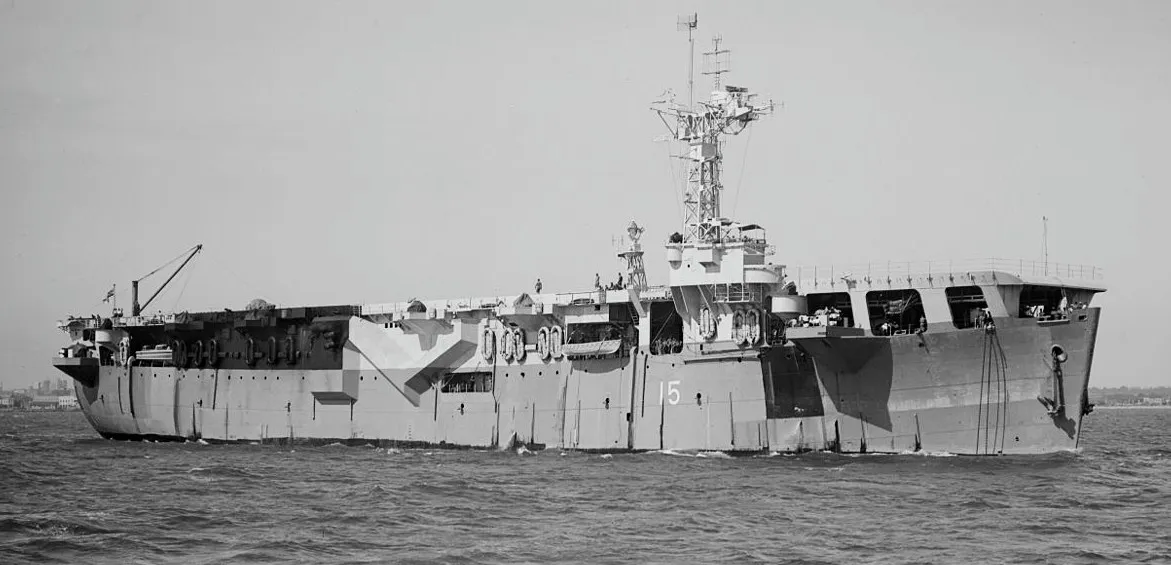
(State Library of Victoria Photo)
HMS Vindex (D15) in December 1945.
HMS Vindex (D15) was a Nairana-class escort carrier of the Royal Navy that saw service during the Second World War. She was built at Swan Hunter shipyards in Newcastle upon Tyne. When construction started in 1942 she was intended as a merchant ship, but was completed and launched as an escort carrier, entering service at the end of 1943.Vindex operated escorting convoys and doing anti-submarine work in the Atlantic and Arctic theatres. Her Swordfish aircraft were involved in the sinking of four U-boats during her service. She survived the war, and immediately afterwards served in the Far East transporting men and material to and from Japan. In 1947, she was decommissioned and sold for commercial use, to Port Line and renamed Port Vindex. In 1971, she was scrapped in Taiwan. (Wikipedia)
HMS Pretoria Castle (F61)
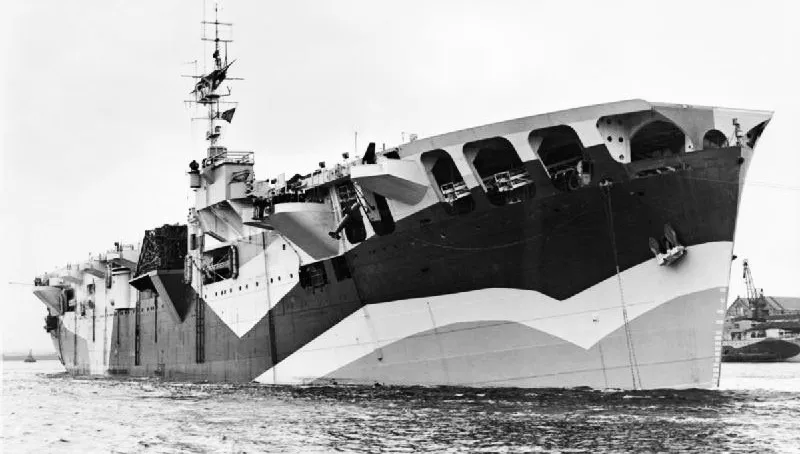
(IWM Photo, FL 17631)
HMS Pretoria Castle (F61) was a Union-Castle ocean liner that in the Second World War was converted into a Royal Navy armed merchant cruiser, and then converted again into an escort carrier. e 17,400 tons, 17 knots, 15 aircraft, laid down in 1943.After the war she was converted back into a passenger liner and renamed Warwick Castle. (Wikipedia)
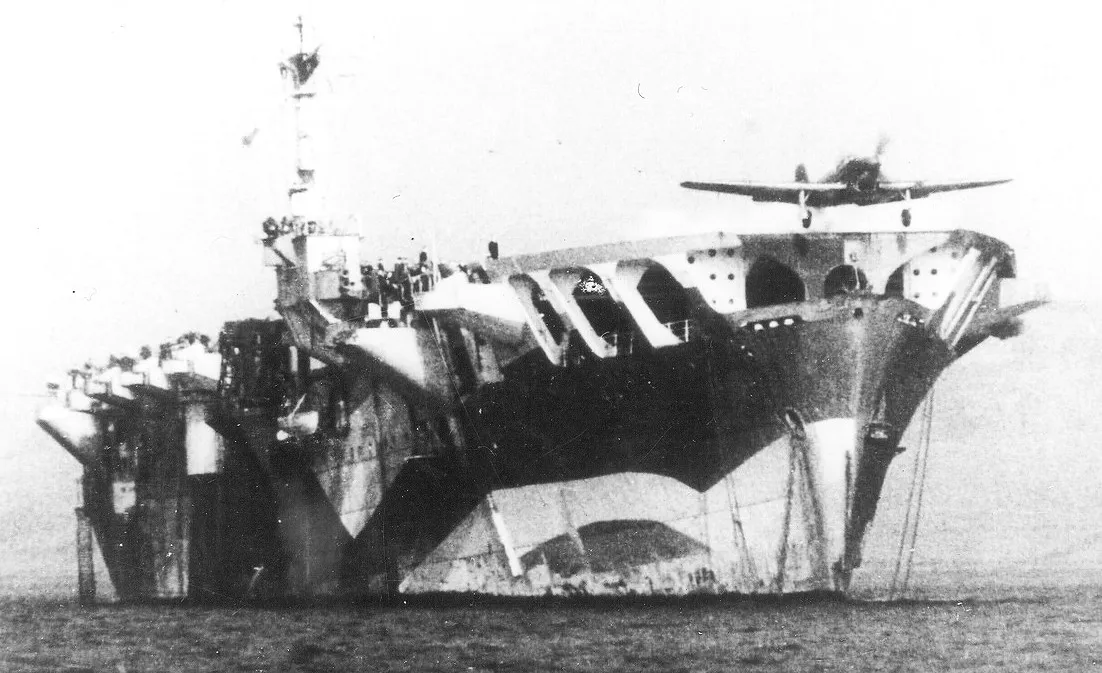
(Fotoafdrukken Koninklijke Marine Photo)
Hawker Sea Hurricane flight training, HMS Pretoria Castle (F61).
Merchant Aircraft Carriers (MAC-Ships)
Oil or grain bulk cargo carriers with superstructures removed and flight decks added. Manned by Merchant Navy crews,with Fleet Air Arm (FAA) personnel to maintain and fly the aircraft - mainly A/S Fairey Swordfish and Hawker Sea Hurricanes. The ships flew the Red Ensign, and some aircraft carried ‘Merchant Navy’ instead of ‘Royal Navy’ on their fuselage.
Hundreds of Empire ships were employed by the Government of the United Kingdom. They were acquired from a number of sources: many were built for the government; others obtained from the United States; still others were captured or seized from enemy powers. Empire ships were mostly used during the Second World War by the Ministry of War Transport(MoWT), which owned the ships but contracted out their management to various shipping lines.
Empire-class Grain Carriers, Empire MacAlpine, Empire MacKendrick, Empire MacAndrew, Empire MacDermott, Empire MacRae, Empire MacCallum, 7 ships - 8,000 tons, 12 knots, 4 aircraft, crewnot known, launched December 1942-January 1944. Equipped with hangar and lift.
MV Empire MacAlpine
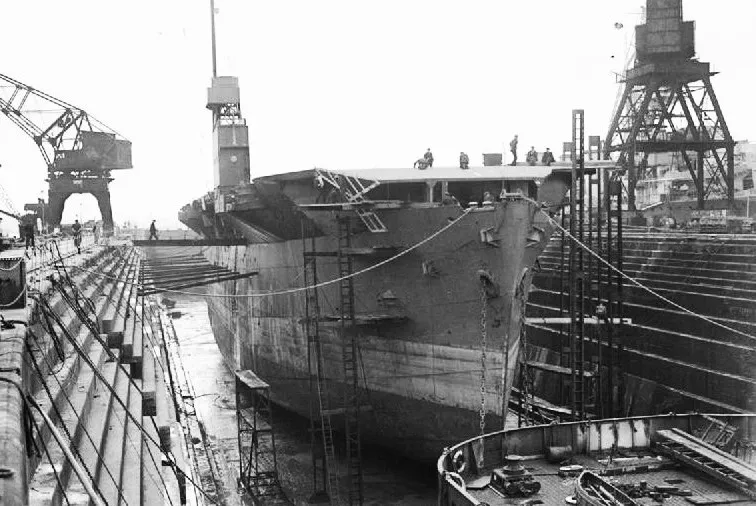
(IWM Photo, A 18012)
MV Empire MacAlpine in dry dock at Messrs Cammel Lairds at Birkenhead.
MV Empire MacAlpine in dry dock at Messrs Cammel Lairds at Birkenhead.MV Empire MacAlpine was a grain ship converted to become the first Merchant Aircraft Carrier (MAC ship).The Burntisland Shipbuilding Company, Fife, Scotland, built her under order from the Ministry of War Transport and was delivered on 14 April 1943. As a MAC ship, only her air crew and the necessary maintenance staff were naval personnel. She was operated by William Thomson & Co (the Ben Line).After the war she was converted to a grain carrier. She was scrapped in Hong Kong in 1970. (Wikipedia)

(IWM Photo, A 27324)
MV Empire MacAlpine in coastal waters.
MV Empire MacKendrick
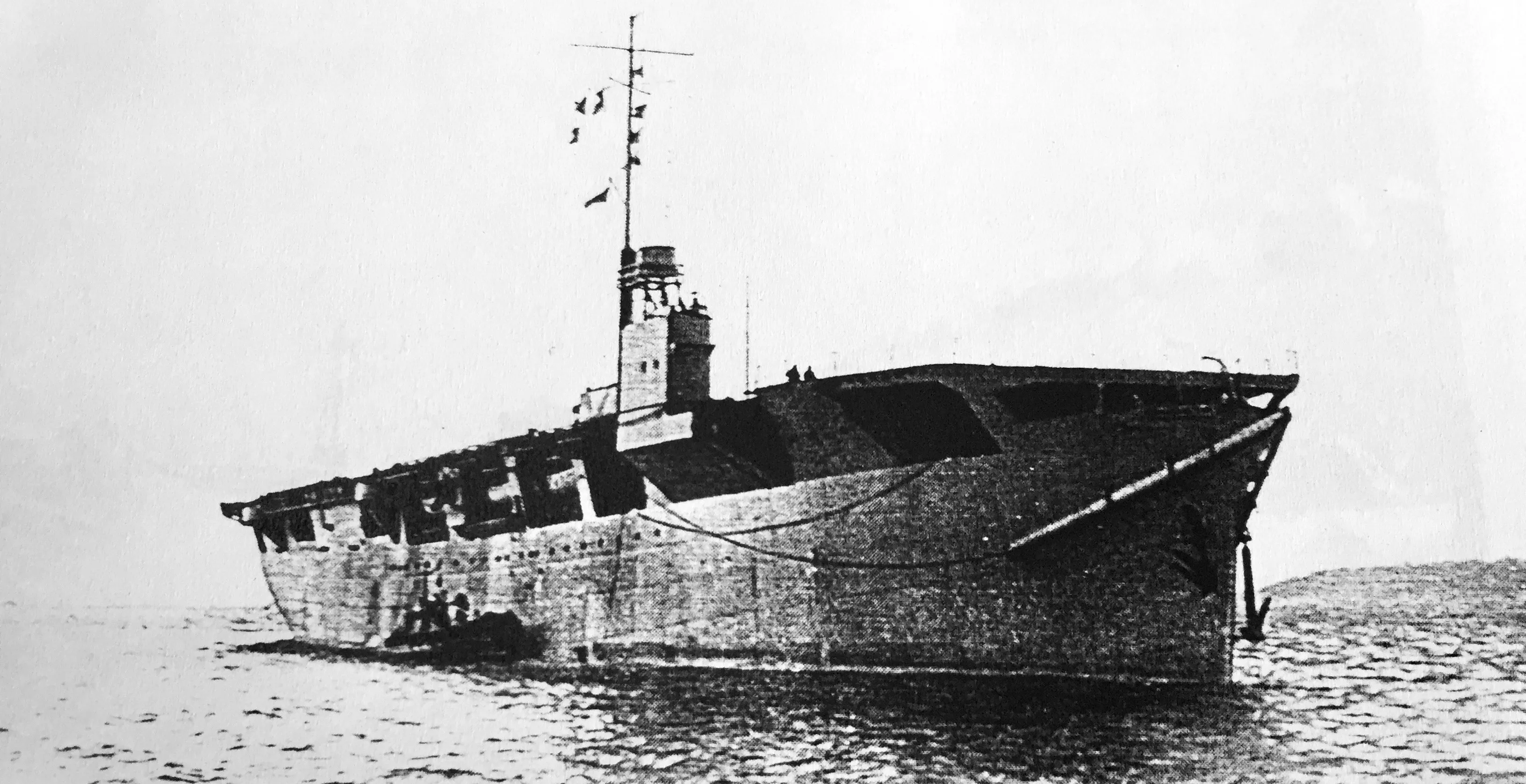
(RN Photo)
The Burntisland Shipbuilding Company Ltd, Fife, Scotland, built her under order from the Ministry of War Transport and was delivered on 12 December 1943. As a MAC ship, only her air crew and the necessary maintenance staff were naval personnel. She was operated by William Thomson & Co (the Ben Line). After the war the ship was converted to a grain carrier. In 1967, while under Bulgarian management, she was trapped in the Suez Canal by the Six-Day War. She was scrapped at Split in 1975. (Wikipedia)
MV Empire MacAndrew

(IWM Photo, A 18027)
MV Empire MacAndrew off Greenock, Scotland, between 1943 and 1945.
MV Empire MacAndrew was a grain ship converted to become a Merchant Aircraft Carrier or MAC ship. MV Empire MacKendrick was built at William Denny and Brothers Dumbarton Scotland under order from the Ministry of War Transport. As a MAC ship, only her air crew and the necessary maintenance staff were naval personne and she was operated by The Hain Steamship Company Ltd, St Ives, Cornwall. After the war, the ship was converted back to a grain carrier, and eventually scrapped in China in 1970. (Wikipedia)
MV Empire MacDermott

(RN Photo)
MV Empire MacDermott was a bulk grain ship built as a Merchant Aircraft Carrier (MAC ship). She served with the British Merchant Navy during the Second World War, with rudimentary aircraft handling facilities operated by a Fleet Air Arm "air party". Empire MacDermott was built by William Denny and Brothers, Dumbarton, Scotland. She spent most of her time on the Atlantic convoy routes, providing air cover and transporting desperately needed grain to the UK. After the end of the, she was handed over to Buries Markes Ltd, London in 1947 and returned to merchant service the following year under the name La Cumbre. She was sold on again in 1959, this time to Canero Cia Nav. S. A., Panama. They sailed her as Parnon under the Greek flag until 1969, when they sold her to Southern Shipping & Enterprises, Hong Kong. They renamed her Starlight, and sailed her under the Somalian flag. She was then transferred to the China Ocean Shipping Co, Peking in 1975, and by 1991 she had been deleted from Lloyd's Register. (Wikipedia)
MV Empire MacRae
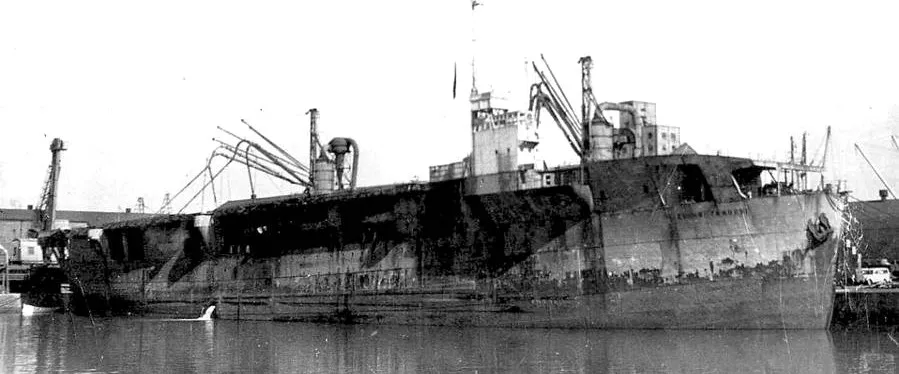
(RN Photo)
MV Empire MacRae was a grain ship converted to become a Merchant Aircraft Carrier or MAC ship during the Second World War. She was built at Lithgows shipyard in Glasgow, Scotland, under order from the Ministry of War Transport. As a MAC ship, only her air crew and the necessary maintenance staff were naval personnel and she was operated by Hain Steam Ship Co Ltd of St Ives.After the war, the ship was converted to a grain carrier and was eventually scrapped at Kaohsiung in 1971. (Wikipedia)
MV Empire MacCallum

(RN Photo)
MV Empire MacCallum was a grain ship converted to a merchant aircraft carrier or MAC ship. MV Empire MacCallum was built at Lithgows shipyard, Glasgow, Scotland, under order from the Ministry of War Transport. As a MAC ship, only her air crew and the necessary maintenance staff were naval personnel, She was operated by Hain Steam Ship Co Ltd of St Ives. On 7 July 1944, a Fairey Swordfish aircraft mistakenly sank the Free French submarine Perle in the Atlantic Ocean off the coast of Newfoundland. Among the aircraft that served on Empire MacCallum was Fairey Swordfish Mk II (Serial No. LS326) where it became part of 'K' flight. The aircraft had previously been on Rapana. In November 2010, it was airworthy with the Royal Navy Historic Flight. After the war, the ship was converted to a grain carrier, and eventually scrapped at Osaka in 1960. (Wikipedia)
Empire-Class Oil Tankers, Empire MacKay, Empire MacColl, Empire MacMahon, Empire MacCabe, 4 ships- 9,000 tons, 12 knots, 3 aircraft, crew not known, launched May-July 1943. No hangar and lift; aircraft stored and maintained on deck.
MV Empire MacKay
MV Empire MacKay was an oil tanker constructed with rudimentary aircraft handling facilities as a merchant aircraft carrier (MAC ship). MV Empire MacKay was built by Harland & Wolff, Govan under order from the Ministry of War Transport. She entered service as a MAC ship in October 1943, however only her air crew and the necessary maintenance staff were naval personnel. She was operated by the British Tanker Company. She returned to merchant service as an oil tanker in 1946 as British Swordfish and she was eventually scrapped in Rotterdam in 1959. (Wikipedia)
MV Empire MacColl

(IWM Photo)
MV Empire MacColl, sometime between 1943 and 1945.
MV Empire MacColl was an oil tanker converted to a merchant aircraft carrier (MAC) ship. MV Empire MacColl was built by Laird, Son & Co., Birkenhead under order from the Ministry of War Transport. She entered service as a MAC ship in November 1943, however only her air crew and the necessary maintenance staff were naval personnel. She was operated by the British Tanker Company. She returned to merchant service as an oil tanker in 1946 and was eventually scrapped in Faslane in 1962. (Wikipedia)
MV Empire MacMahon
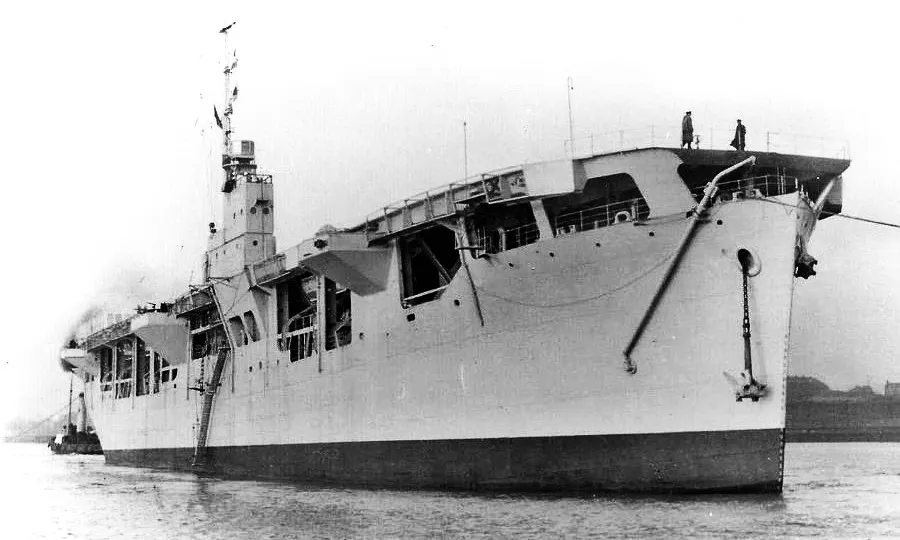
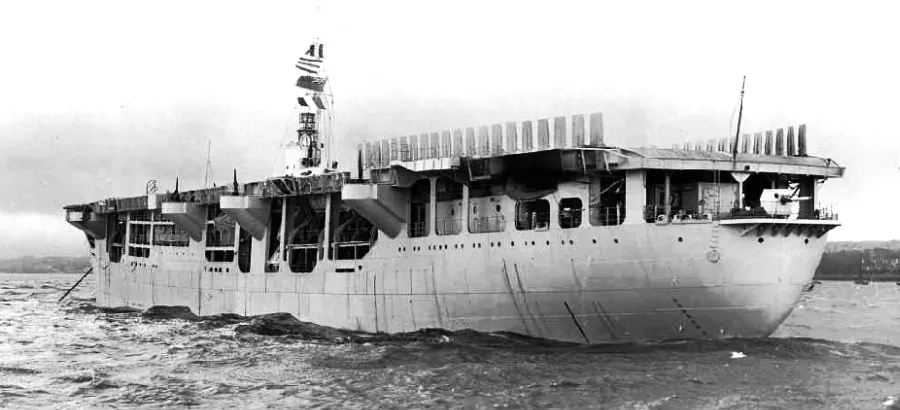
(Photoship Photos)
MV Empire MacMahon was an oil tanker converted to a merchant aircraft carrier or MAC ship. MV Empire MacMahon was built by Swan Hunter, Wallsend under order from the Ministry of War Transport. She entered service as a MAC ship in December 1943; however, only her air crew and the necessary maintenance staff were naval personnel. She was operated by Anglo-Saxon Petroleum Co. She returned to merchant service as an oil tanker in 1946 and renamed Naninia and was eventually scrapped in Hong Kong in 1960. (Wikipedia)
MV Empire MacCabe
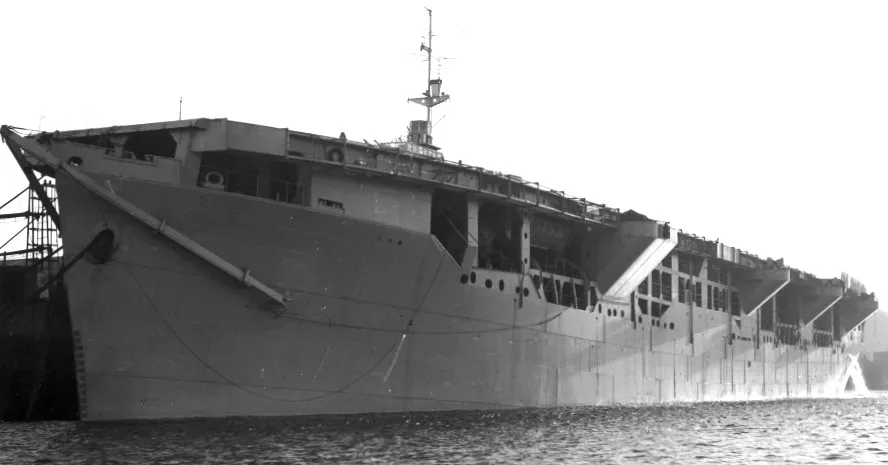
(Kevin Blair Photo)
MV Empire MacCabe was a British oil tanker converted to a merchant aircraft carrier (or MAC ship), during the Second World War. MV Empire MacCabe was built by Swan Hunter, Wallsend under order from the Ministry of War Transport. She entered service as a MAC ship in December 1943, however only her air crew and the necessary maintenance staff were naval personnel. She was operated by the British Tanker Company. She returned to merchant service as an oil tanker in 1946 and was scrapped in Hong Kong in 1962. (Wikipedia)
Rapana-Class Oil Tankers, Acavus, Adula, Alexia, Amastra, Ancylus, Gadila, Macoma, Miralda, Rapana, 9 ships - 12,000 tons, 12 knots, 3 aircraft, crew not known, converted 1942-44. Anglo-Saxon Petroleum Company tankers. ‘Gadila’ and ‘Macoma’ operated under the Dutch ensign. No hangar and lift; aircraft stored and maintained on deck.
MV Acavus
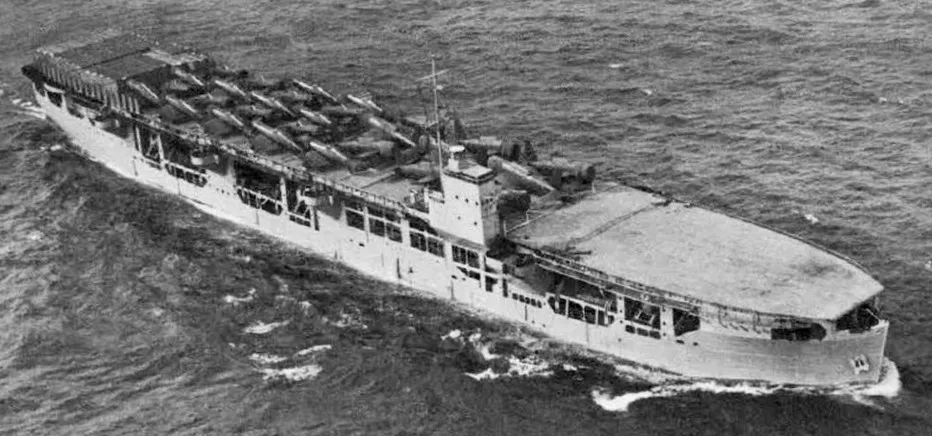
(RN Photo)
MV Acavus, carrying a deck load of Corsairs and Vengeances.
MV Acavus was a motor tanker that was built in 1935, and converted into a merchant aircraft carrier (MAC) in 1943. She was built for Anglo-Saxon Petroleum, which is part of Royal Dutch Shell. In 1952 she was transferred to a French subsidiary of Shell and renamed Iacra. She was scrapped in France in 1963. Acavus was the last ship ever built by Workman, Clark and Company. The company was founded in 1879, and went into receivership in May 1935, about four months after completing Acavus. (Wikipedia)
MV Adula
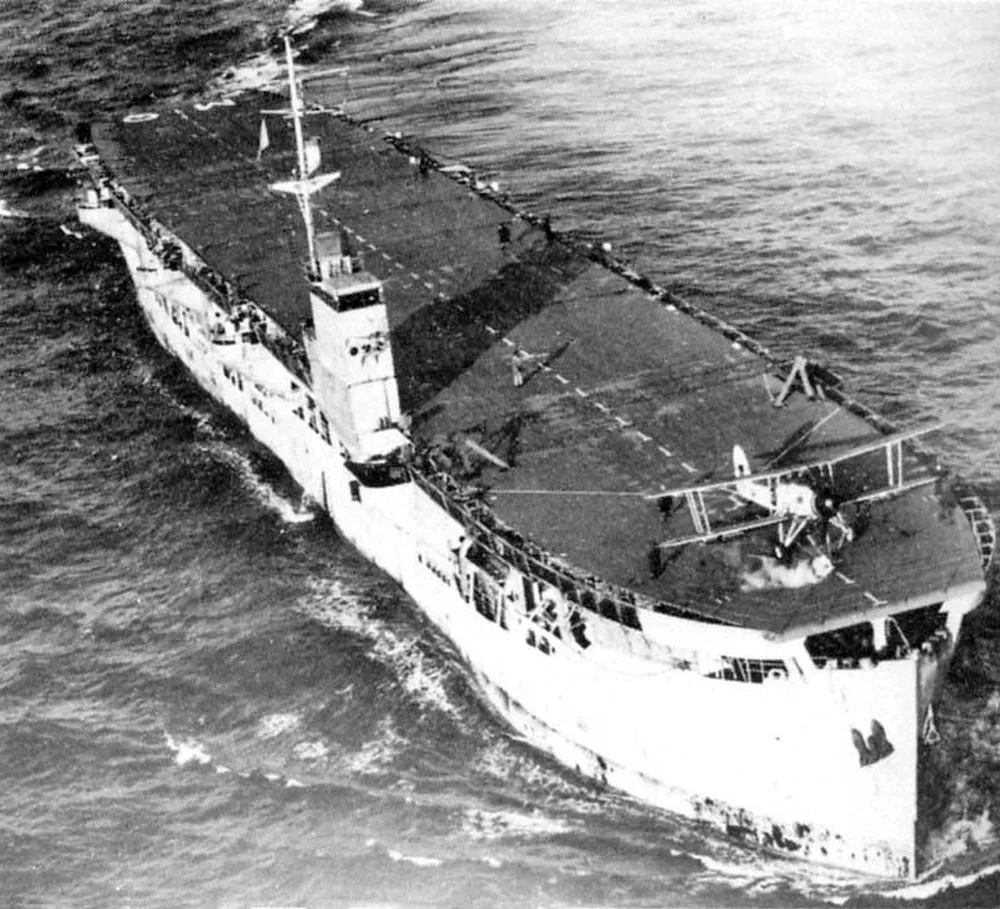
(RN Photo)
MV Adula was one of nine Royal Dutch/Shell oil tankers converted to become a Merchant Aircraft Carrier (MAC ship). The group is collectively known as the Rapana class. MV Adula was built at Blytheswood and completed in March, 1937 as an oil tanker for the Royal Dutch/Shell line. She was converted at Falmouth to a MAC ship, entering service in February 1944. As a MAC ship, she had no aircraft hangar, and continued to carry normal cargoes, although operating under Royal Navy control. Only her air crew and the necessary maintenance staff were naval personnel. At the end of the war, Adula was reconverted to an oil tanker. She served in this capacity until broken up for scrap at Briton Ferry in May 1953. (Wikipedia)
MV Alexia
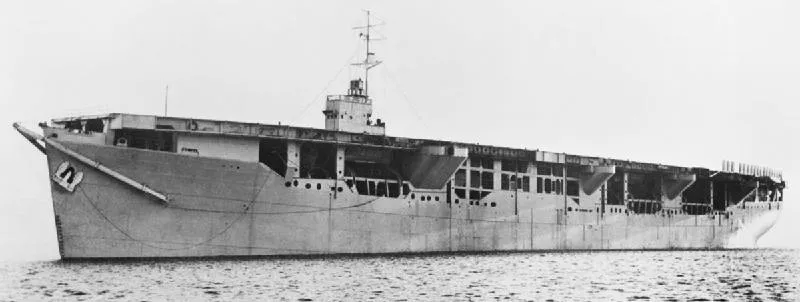
(IWM Photo, A 27325)
MV Alexia was one of nine Royal Dutch/Shell oil tankers converted to become a Merchant Aircraft Carrier (MAC ship). The group is collectively known as the Rapana class. MV Alexia was built at Bremer Vulkan and completed in April, 1935 as an oil tanker for the Anglo-Dutch Royal Dutch/Shell line. She sustained severe damage in two separate U-boat attacks in 1940 and 1942. After the second attack was converted to a MAC ship, entering service in December 1943. As a MAC ship, she had no aircraft hangar, and continued to carry normal cargoes, although operating under Royal Navy control. Only her air crew and the necessary maintenance staff were naval personnel. At the end of the war, Alexia was reconverted to an oil tanker, and renamed Ianthina in 1951. She served in this capacity until broken up for scrap at Blyth in 1954. (Wikipedia)
MV Amastra
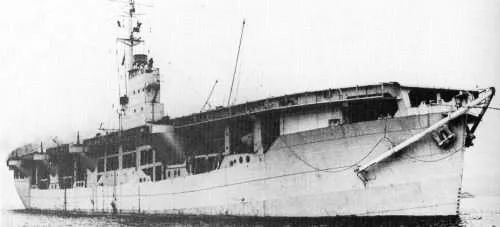
(RN Photo)
MV Amastra was one of nine Anglo-Saxon Royal Dutch/Shell oil tankers converted to become a Merchant Aircraft Carrier (MAC ship). The group is collectively known as the Rapana class. MV Amastra was built at Lithgows and completed in March, 1935 as an oil tanker for the Royal Dutch/Shell line. She was converted at Smiths Dock, North Shields to a MAC ship, entering service in September 1943. As a MAC ship, she had no aircraft hangar, and continued to carry cargo, although operating under Royal Navy control. Only her air crew and the necessary maintenance staff were naval personnel. At the end of the war, Amastra was reconverted to an oil tanker, and in 1951 was renamed Idas. She served in this capacity until broken up for scrap at La Spezia in June 1955. (Wikipedia)
MV Ancylus
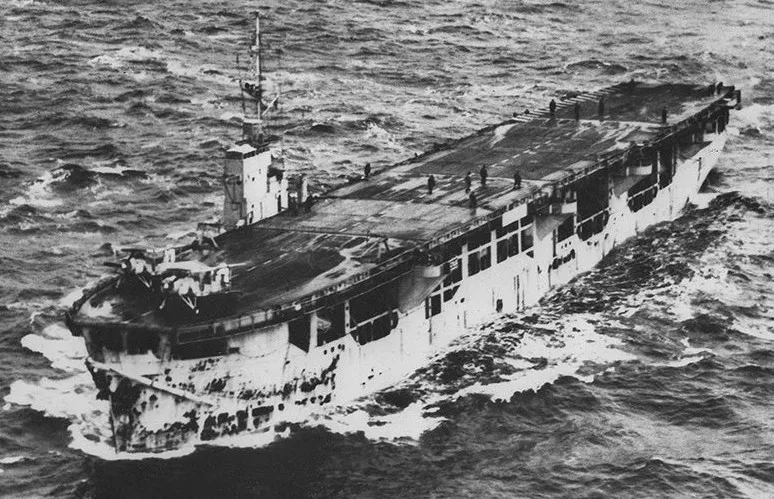
(IWM Photo)
MV Ancylus was one of nine Anglo Saxon Royal Dutch/Shell oil tankers converted to become a Merchant Aircraft Carrier (MAC ship). The group is collectively known as the Rapana class. MV Ancylus was built at Swan Hunter and completed in January, 1935 as an oil tanker for the Anglo Saxon Royal Dutch/Shell line. She was converted to a MAC ship, entering service in October, 1943. As a MAC ship, she had no aircraft hangar, and continued to carry normal cargoes, although operating under Royal Navy control. Only her air crew and the necessary maintenance staff were naval personnel. At the end of the war, Ancylus was reconverted to an oil tanker, being renamed Imbricaria in 1952. She served in this capacity until broken up for scrap at La Spezia in December 1954. (Wikipedia)
MV Gadila
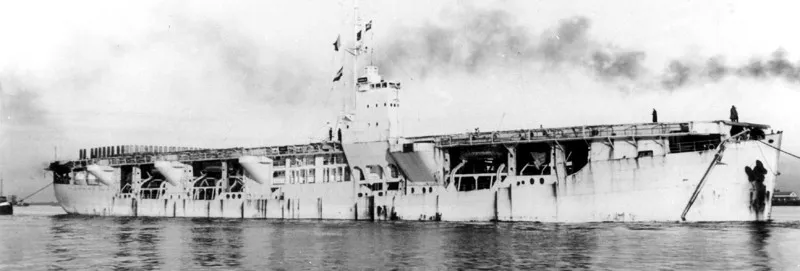
(Ministry of Defence, Netherlands Photo)
MV Gadila was one of nine Anglo Saxon Royal Dutch/Shell oil tankers converted to become a Merchant Aircraft Carrier (MAC ship). The group is sometimes collectively known as the Rapana class. MV Gadila was built at the Howaldtswerke, Kiel, Germany and completed 11 April 1935 as an oil tanker for the Royal Dutch/Shell line. She was converted at Smith's Dock, North Shields between April 1943 and 1 February 1944. She entered service as a MAC ship in March 1944, and operated under the Netherlands Mercantile Marine flag. As a MAC ship, she had no aircraft hangar, and continued to carry normal cargoes with a mercantile ship's crew, although operating under British Royal Navy control. Only her air crew and the aviation support staff were Naval personnel. In the case of the Gadila, these were provided by the Royal Netherlands Navy and served as elements of Fleet Air Arm 860 (Dutch) Naval Air Squadron. The Gadila and her sister MV Macoma were the first aircraft carrying vessels with a flight deck to be operated under the flag of the Netherlands. At the end of the war, Gadila was reconverted to an entirely mercantile oil tanker and served in this capacity until broken up for scrap in Hong Kong in 1958. (Wikipedia)
MV Macoma
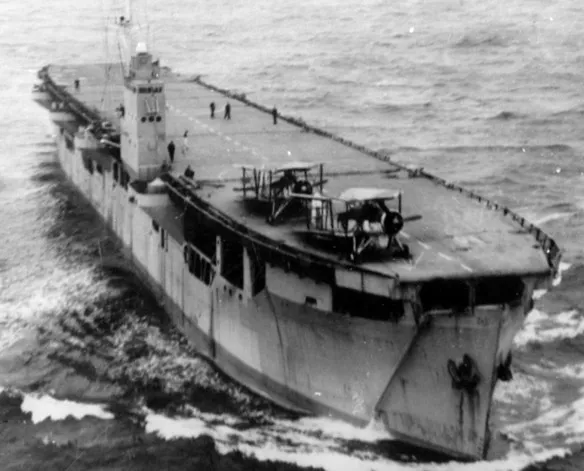
(Ministry of Defence, Netherlands Photo)
MV Macoma was one of nine Anglo Saxon Royal Dutch/Shell oil tankers converted to become a Merchant Aircraft Carrier (MAC ship). The group is sometimes collectively known as the Rapana Class. Macoma was launched on 31 December 1935 at Nederlandse Scheepsbouw Mij, Amsterdam as an oil tanker and entered service the following year. She was converted to a MAC ship from late 1943 to April 1944, and commissioned 1 April 1944. As a MAC ship, she had no aircraft hangar, and continued to carry normal cargoes, although operating under Royal Navy control. Only her air crew and aviation support staff were naval personnel.[2] In the case of the Macoma, these were provided by the Royal Netherlands Navy including the Dutch Fleet Air Arm 860 and 861 squadrons. The Macoma and her sister MV Gadila were the first aircraft carrying vessels with a flight deck to be operated under the flag of the Netherlands. After the war, MV Macoma was reconverted and returned to merchant service as an oil tanker and served in that role until scrapped in Hong Kong in 1959. (Wikipedia)
MV Miralda
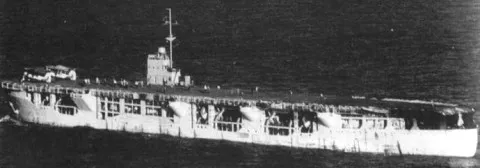
(RN Photo)
MV Miralda was one of nine Anglo Saxon Royal Dutch/Shell oil tankers converted to become a Merchant Aircraft Carrier (MAC ship). The group is collectively known as the Rapana class. Macoma was launched in July 1936 at Nederlandse Scheepsbouw Mij, Amsterdam as an oil tanker. Her conversion to a MAC ship was completed in January 1944. As a MAC ship, she had no aircraft hangar, and continued to carry normal cargoes, although operating under Royal Navy control. Only her air crew and the necessary maintenance staff were naval personnel. The British Ship Adoption Society, a Maritime Charity, was formed in the early part of the Second World War, with a large number of schools taking part in the scheme, amassing comforts for a particular ship and in return the children would receive letters of thanks and news from various ports around the world to which it would sail. the M.V Miralda was adopted by Styal Cottage Homes, a home colony and school for orphaned and destitute children of Manchester. After the war, Miralda was reconverted and returned to merchant service as an oil tanker and served in that role until scrapped in Hong Kong in 1960. She was renamed Marisa in 1950. (Wikipedia)
MV Rapana
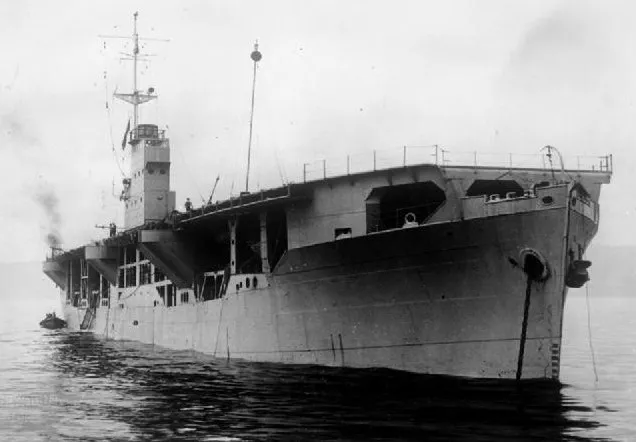
(IWM Photo, FL 18159)
MV Rapana was a Dutch-built oil tanker converted to a Merchant Aircraft Carrier (MAC ship) during the Second World War. She was the first tanker to be converted to a MAC ship, and was the lead ship of her class of conversions. Rapana was launched as a tanker in April 1935, and served as a merchant vessel until July 1943, when she was converted into a MAC ship. After the end of the Second World War, the ship was converted back into a tanker and returned to civilian service. In 1950 she was sold and renamed Rotula. She was scrapped in Osaka in January 1958. MV Rapana was built as a “Triple Twelve” oil tanker,[1] with an overall length of 482 feet (146.9 m), a beam of 59 feet (18.0 m), and a draft of 27 feet 6 inches (8.4 m). She had a gross registered tonnage of 8000 tons, and 16000 tons under full load. Her Sulzer diesel engine provided 4000 bhp driving a single shaft, giving her a maximum speed of 12.5kts. After her conversion, Rapana had a 462 feet (140.8 m) long and 62 feet (18.9 m) wide flight deck. Due to being converted from a tanker, she did not have a hangar and all aircraft were parked on deck. A safety barrier and windbreak were installed on the flight deck to allow for this. These modifications gave her the capacity to operate 3 Swordfish torpedo bombers in anti-submarine duties. A small island was installed on her starboard side, including the bridge, wheelhouse, and flying control position. Her armament included a single 4 inch (102 mm) QF MK IV, as well as 2 single 40mm Bofors guns and 6 single Oerlikon 20 mm cannons. Because the ship was still considered a merchant vessel, her crew of 118 was a mix of merchantmen as well as Royal Navy men, with the latter taking care of aircraft maintenance and operations.(Wikipedia)
.webp)
(Tim Felce, Airwolfhound Photo)
Fairey Swordfish (Serial No. LS326) served aboard her during the war before its transfer to MV Empire MacCallum. From 1960 until its disbandment in March 2019, it was part of the Royal Navy Historic Flight. (Wikipedia)
Catapult Armed Merchantmen (CAM-Ships)

(RAF Photo)
On merchant ships equipped with catapults, Sea Hurricanes were often deployed as standard fighters, despite being nearly worn out. In a last-ditch effort, these aircraft would embark on one final flight, knowing there was no place to land. Instead, pilots would ditch their planes in the sea, hoping for a fortunate rescue. With the eventual arrival of escort carriers, this perilous practice was halted, providing a safer alternative for naval aviation operations.
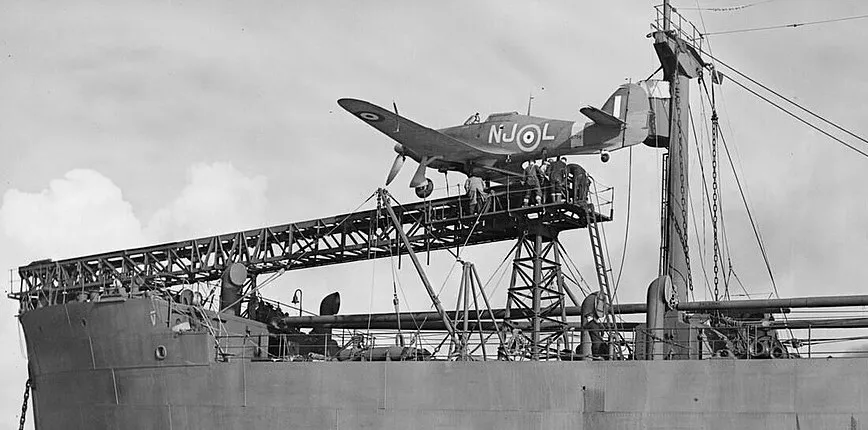
(IWM Photo A 9421)
Hawker Hurricane Mk. IA on the catapult of a CAM (Catapult Armed Merchant) Ship at Greenock, Scotland. The first RAF trial CAM launch was from SS Empire Rainbow at Greenock on the River Clyde on 31 May 1941, the Hurricane landed at Abbotsinch.
CAM ships were ordinary merchant ships fitted with a rocket driven catapult on the forecastle. They carried one Mk. 1(a) Hurricane with minimum modifications and flown by volunteer RAF pilots, known as Sea Hurricanes, ‘Catafighters’ or ‘Hurricats’. Quickly put into service in 1941 before the first escort carriers appeared with the aim of driving off or shooting down German bombers and reconnaissance aircraft, particularly Focke-Wulf Fw 200 Condors. Once flown off, the pilot usually had to ditch and hope tobe picked up or make for the nearest friendly shore. The first ships were requisitioned for Naval Service as Auxiliary Fighter Catapult Ships and sailed under the White Ensign. Later CAM-ships were merchantmen.
CAM sailings were initially limited to North American convoys with aircraft maintenance performed by the Royal Canadian Air Force at Dartmouth, Nova Scotia. CAM ships sailed on Gibraltar and Freetown convoys beginning in September 1941, after an aircraft maintenance unit was established at the RAF base at North Front, Gibraltar. No CAM aircraft were provided during January and February 1942 after it proved impossible to maintain the catapult-mounted aircraft in flying order during the North Atlantic winter. CAM sailings resumed on 6 March 1942 on North Atlantic convoys and in April on the Arctic Russian convoys with an RAF aircraft maintenance unit in Archangelsk. (Wikipedia)
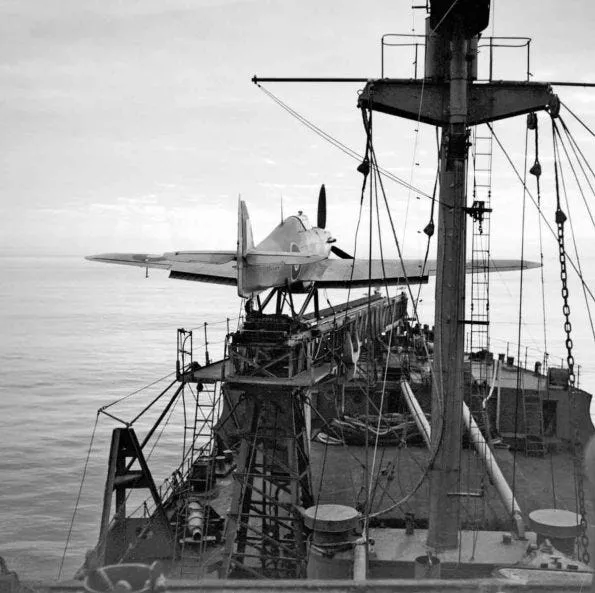
(RN Photo)
Hawker Sea Hurricane Mk I (Serial No. V6733), of the Merchant Ship Fighter Unit, on the fo'c'sle catapult on board Catapult Armed Merchantman (CAM ship) SS Empire Darwin, in a convoy heading for North Africa. Note the flaps pre-selected in the take-off position. The catapult was angled to starboard over the ship's bows to prevent the blast from its rockets hittin…
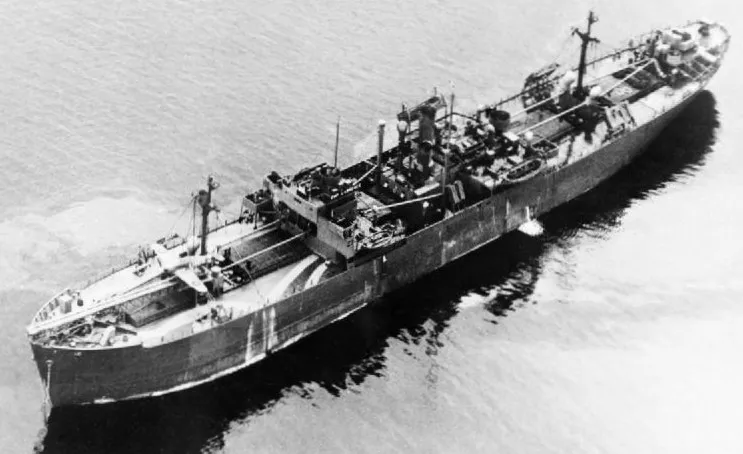
(IWM Photo, FL 11425)
SS Empire Lawrence at anchor, with a Hawker Hurricane mounted on its catapult, c1941.
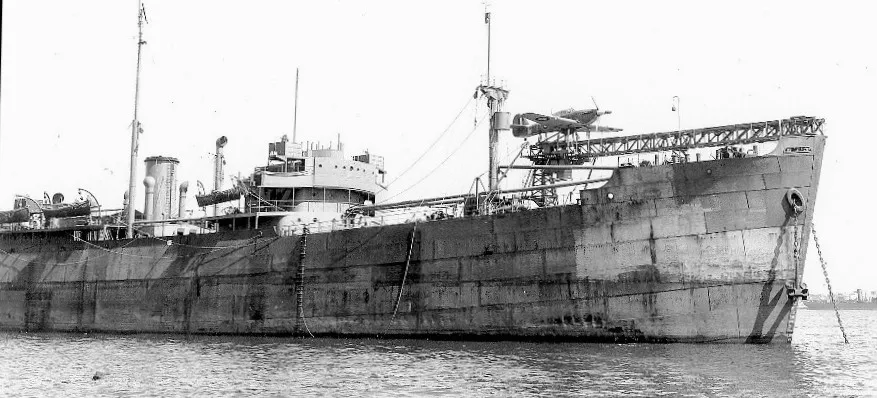
(RN Photo)
Catapult Aircraft Merchantman (CAM Ship) seen here at anchor in Halifax Harbour, Nova Scotia. 35 ships were fitted with catapults in total, 8 were privately owned and 27 were British Ministry of Transport owned Empire ships, this is likely one of the latter.
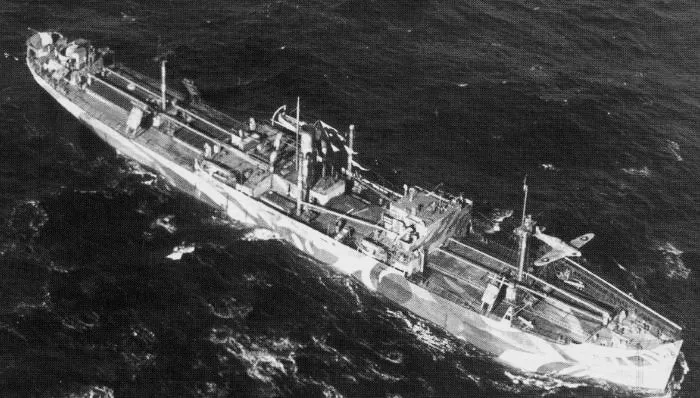
(IWM Photo)
Overhead view of SS Empire Darwin in a dazzle camouflage, showing her catapult and Sea Hurricane to advantage. The catapults were fitted in such a manner so as not to affect the ships’ normal operations in any way, they could still transport their standard cargos. On 28JUL43 Empire Darwin launched her Sea Hurricane which was credited with the destruction of an FW 200 Condor. The Hurricane pilot, PO Stewart, bailed out over the convoy and was rescued.
(IWM Photo)
SS Empire Spray leading a pair of standard merchantmen as part of a convoy formation. Convoys were organized based upon the cruising speed of the merchant ships, it was common to include 25 ships or more plus escorts. The CAM ships were operational until the Summer of 1943 when sufficient numbers of Escort Carriers became available
According to Cdr Rippon in ‘Evolution of Engineering in the Royal Navy’, Volume 2, some 35 CAM-ships made about 175 voyages in two years - twelve were lost, eight catapult launchings were made, six enemy aircraft shot down and one RAF pilot lost. Requisitioned Auxiliary Fighter Catapult Ships included ‘Ariguani’, ‘Maplin’ and two more, which were lost in 1941: HMS Patria and HMS Springbank.
HMS Patia
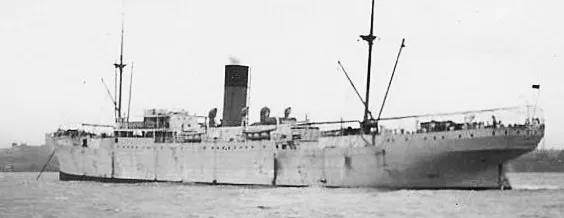
(RN Photo)
HMS Patia, (5,350t, completed 1922, Cdr D M B Baker RNR+), lost on 27 April 1941, Western Europe, sunk by German bombers, 40 crew lost. The remains of the 1941 wreck of this British aircraft catapult vessel which foundered 6 miles east of Beadnell Point after being bombed en route from the River Tyne for Belfast lie near 20G Buoy, Coquet Island, off Northumberland, NE coast of England. Before foundering her gunners managed to shoot down the attacking aircraft. Built in 1922, she was a steel screw steamer requisitioned by the Admiralty. HMS Patia was 400ft steamship with a 51ft beam, serving as a fighter aircraft catapult ship in WWII, carrying Swordfish spotter aircraft armed with light torpedoes. She weighed 5,355 gross tonnes and her role was to spot, and if possible, destroy, enemy submarines.
HMS Springbank
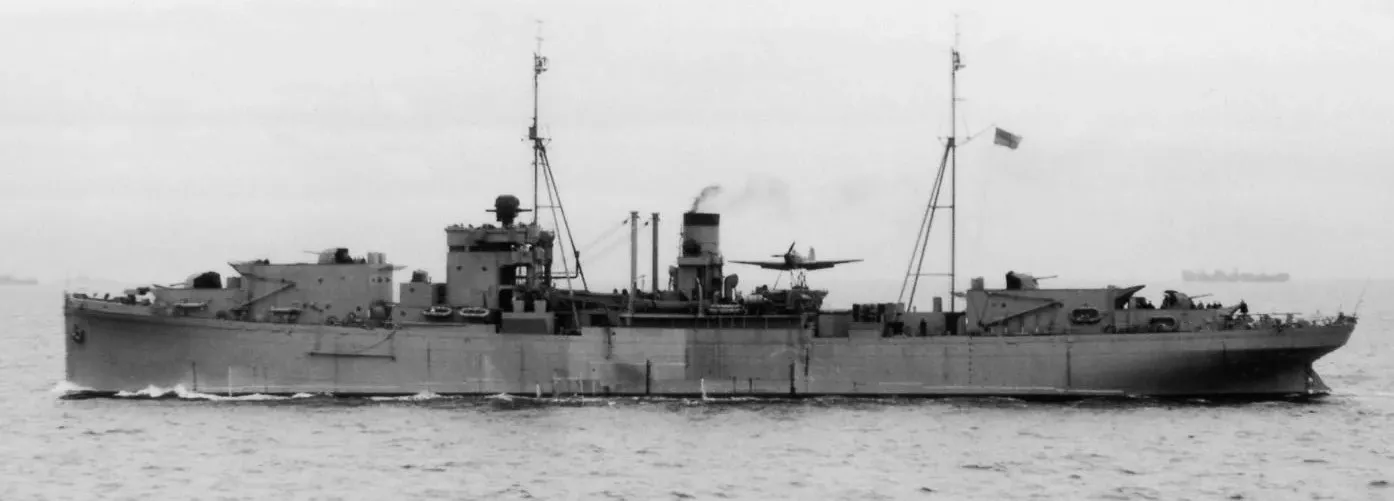
(RN Photo)
Fairey Fulmar onboard the Fighter Catapult Ship HMS Springbank, similar in concept, size and presumably appearance, to HMS Patia. Note the Fulmar on the catapult amidships.
HMS Springbank, (5,150t, completed 1926, Capt C H Godwin), lost on 27 September 1941, North Atlantic (49.10N, 20.05W), torpedoed by German ‘U.201’ (Schnee); 32 crew lost.

